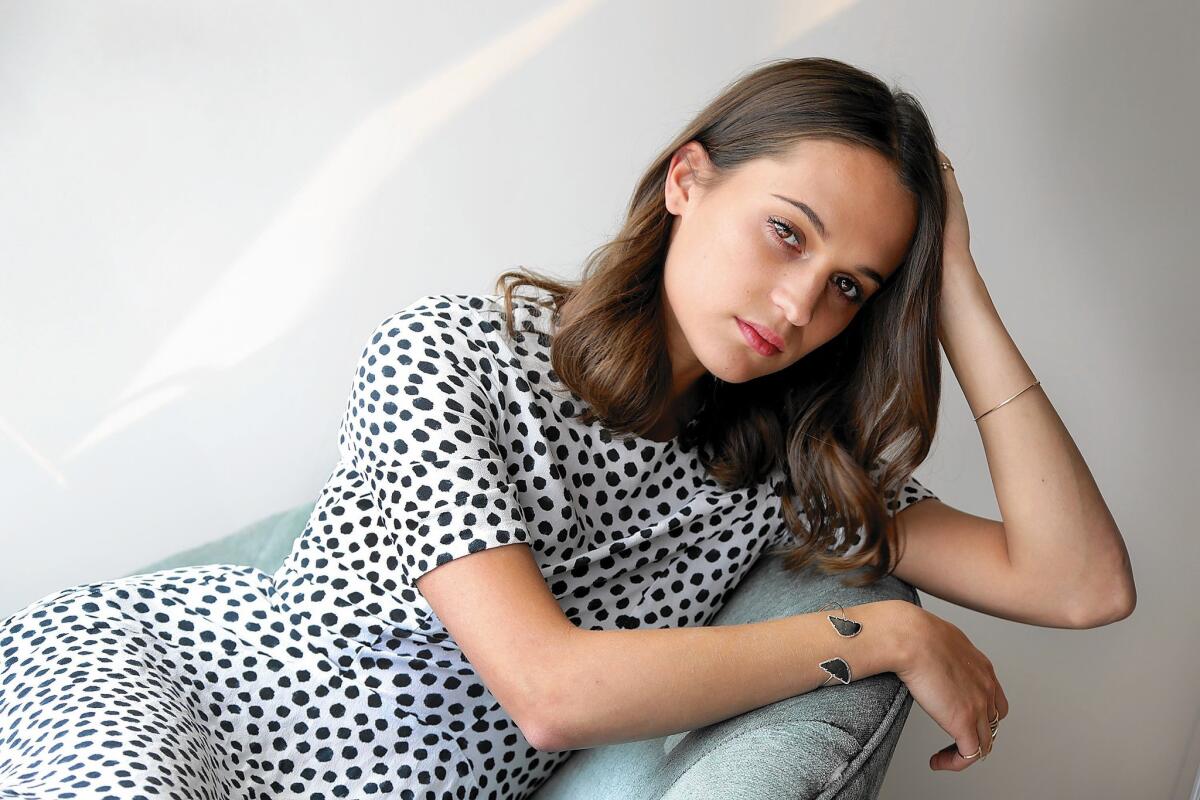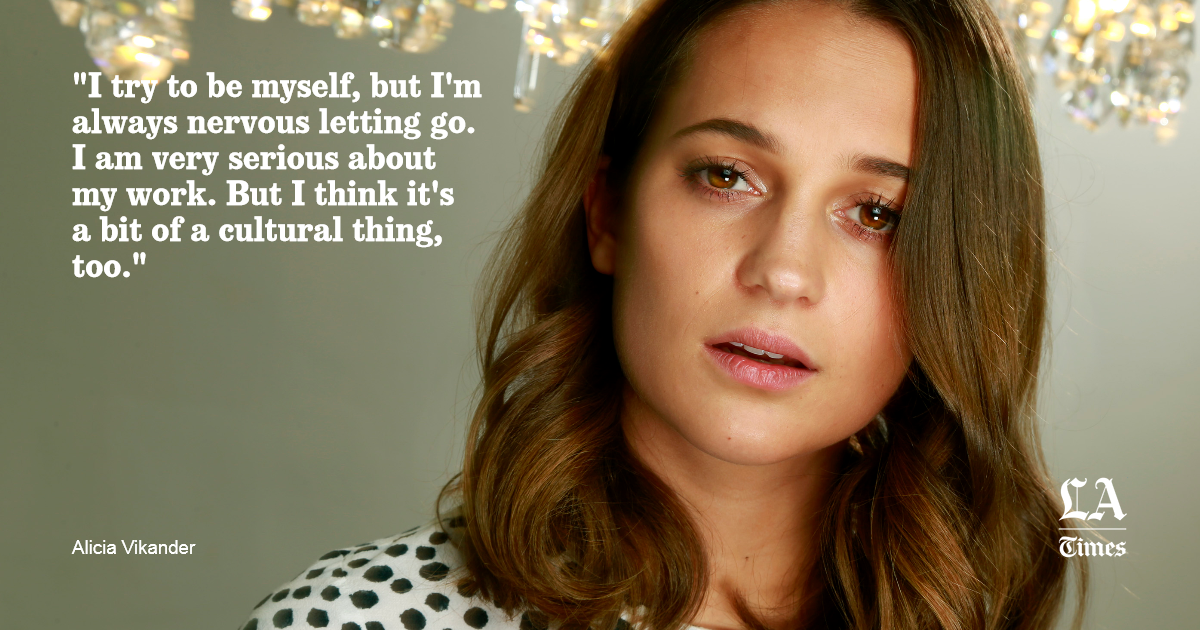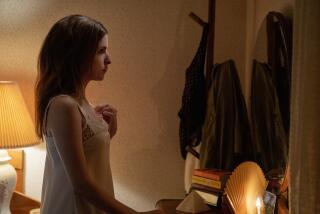Alicia Vikander digs deep for sympathy in transgender film ‘Danish Girl’

Alicia Vikander was 15 when she moved away from home. She didn’t know how to do her own laundry. But she wanted to be a ballerina, and the best dance school was in Stockholm, a four-hour drive from the city where she’d grown up in Sweden.
So she found a flat to rent — there weren’t any dormitories at the Royal Swedish Ballet School then — and moved in, alone. Her days began at 6:30 a.m., and she attended classes six days a week. By 17, she was so stressed that a nurse suggested she start seeing a therapist.
Soon she would withdraw from the program to pursue acting. But these would prove to be formative years for Vikander. They help to explain how, during the first three years of her Hollywood career, she’s shot more than a dozen movies. Five of those films — including the sci-fi thriller “Ex Machina” and the remake of “The Man from U.N.C.L.E.” — are 2015 releases.
SIGN UP for the free Indie Focus movies newsletter >>
The latest, for which she is widely expected to receive an Oscar nomination, is “The Danish Girl.” Out Nov. 27, the film is based on the story of artist Lili Elbe (Eddie Redmayne), one of the first people in the world to receive gender reassignment surgery. Vikander plays Gerda Wegener, Lili’s wife, who is struggling to come to terms with her partner’s newfound identity.
The role marks the latest in a string of critically acclaimed performances for Vikander, who at 27 has already established herself as a serious actress with an astonishingly wide bandwidth: intimidatingly robotic (“Ex Machina”), hopelessly romantic (“Testament of Youth”), doggedly loyal (“The Danish Girl”).
But off-screen, she’s earned less positive reviews. The press has often found her to be aloof, describing her as “cooly remote,” “polite but not warm” and “certainly not vulnerable.”
And that’s not how millennials want their stars these days. In a Vogue cover story this month, Jennifer Lawrence takes off her bra in front of a reporter, ditches fancy dinner plans to order pizza and talks about her hymen. Vikander, meanwhile, looks like she could be the princess of a small European nation you’ve never heard of. You can tell she used to be a dancer because she’s quite dainty. It’s easy to imagine her with her hair slicked back into a bun, nothing hiding her delicate, symmetrical face.
Plus: It’s not Ah-lee-sha, it’s Ah-liss-sia.
But when asked about her reputation for being cold, Vikander became visibly upset. Red splotches even started to form on her neck.

Alicia Vikander on acting.
“It’s tough,” she said, coming off four hours’ sleep after flying in from the set of the new “Bourne Identity” installment. “I try to be myself, but I’m always nervous letting go. I am very serious about my work. But I think it’s a bit of a cultural thing, too. Everyone thinks my English is so good. But with the language barrier, I often feel like I want to add that little extra flavor to what I’m saying. Sometimes I wish people could hang out with me for 10 minutes when I’m speaking Swedish.”
Vikander is extremely proficient in English — she lives in London now — but still makes occasional grammatical errors that remind you it’s not her native language, like “part of my brain have forgotten that I did it.”
Many times, she’s felt out of place here. One summer, she attended a New York ballet camp with a childhood friend. When they first saw each other, she ran to gave him a hug but was swiftly reprimanded.
“The teachers were like, ‘PDA! PDA!’” she recalled. “Girls and boys weren’t allowed to hang out after a certain hour.”
Though she grew up watching American television and film, Vikander never thought she’d become a star outside of Sweden. Her mother was a stage actress in her native Gothenburg, and so she too aspired to work in the theater. The film industry in Scandinavia is small, and Vikander had only a few Swedish actresses as role models who’d made it in the U.S.: Greta Garbo, Ingrid Bergman, Noomi Rapace.
Her L.A. story
She was first invited to Los Angeles to screen test for the lead in “Snow White and the Huntsman” — a role that eventually went to Kristen Stewart. But the trip, she said, was magical. She flew business class for the first time, snapping photos of the amenities to send to her mother.
“I was like, ‘It’s so obvious I haven’t done this,’” she said, laughing. “I was pushing every button. And then when I landed I called my mum to say, ‘I’m at Universal — but not the side where all the rides are! The other side!’”
She went on to describe the hotel she stayed in, a Hilton, with equal enthusiasm. She’s quite bubbly — at times even kooky — unafraid to guffaw or do dramatic imitations of her colleagues while seated in the Chateau Marmont’s austere lobby. It was in part this lack of self-consciousness that made director Tom Hooper want to cast her in “The Danish Girl.”
“I think there’s a tradition in English acting of emotional repression,” said the British director, who won an Oscar for “The King’s Speech.” “In Scandinavian tradition, they’re not so uptight emotionally. Alicia’s emotions are kind of quick to rise. And she was also completely fearless about nudity and sex scenes. That’s definitely not British. Me and Eddie were much more nervous.”
The director was so adamant that Vikander was right for “The Danish Girl” that when she had a scheduling conflict, production was put on hold for five months to accommodate her. So she went off to New Zealand to film Derek Cianfrance’s “The Light Between Oceans” opposite Michael Fassbender — now rumored to be her boyfriend — before returning to London in February for Hooper’s film.
“We just knew that she was right, so we decided it was worth it to shut everything down and wait,” said Gail Mutrux, one of “Danish Girl’s” producers. “She always resists making an obvious sentimental choice in the most emotional scenes.”
“The Danish Girl” is hitting theaters at the tail end of a year in which transgender stories finally began to appear on-screen. In April, Olympian Bruce Jenner announced he was transitioning to Caitlyn Jenner, appearing for the first time as a woman on the July cover of Vanity Fair; her journey was later documented on an E! reality series. Amazon’s “Transparent,” starring Jeffrey Tambor as a retired college professor who tells his family he wants to live as a woman, took five Emmys in September.
In “The Danish Girl,” Vikander’s character asks her husband to pose as a female model for one of her portraits. Days after the painting is finished, she’s stunned to come home and find her husband still dressed in stockings and high heels. That’s when she has to decide whether to help Lili through her transition or end the marriage.
“In preparing for the role, I met with those close to people who have transitioned,” Vikander said. “And they all wanted to tell me, ‘People forget that I went on a transition, too. I felt a bit lonely and needed support.’ And sometimes in playing Gerda, I felt like, ‘This is so tough. How could she do it?’”
Alicia’s emotions are kind of quick to rise. And she was also completely fearless about nudity and sex scenes. That’s definitely not British.
— Director Tom Hooper
At times, Vikander found it difficult to separate her feelings about the situation from her performance. When Gerda finds out her husband has secretly been dressing as a woman, she asked Hooper, wouldn’t she feel deceived?
“Alicia said, ‘Surely, my first reaction would be betrayal. I’d feel like there was a secret going on,’” Hooper explained. “I had to say to her: ‘However compassionate we are, Gerda is probably even more compassionate. You’re saying this is how I would feel.’ In pushing Alicia’s compassion, she became inspired by the character to be even more giving in her performance.”
Vikander often finds herself to be one of the more active participants on set. She’s even had trouble adjusting to more-laid back productions, like “The Man From U.N.C.L.E.,” where Guy Ritchie seemed just as concerned with enjoying himself as getting all his shots in on time.
“He was all about having fun and I was standing there, like, ‘Time is money!’” she remembered. “I really do like work — meeting a group of people, staying in your trailers and working 14, 16 hours a day. I feel very comfortable doing just that.”
There is one thing she’s looking forward to the next time she has a break, though. After living out of four bags for the past few years, she recently got her first place in London.
“And just having a shelf to put something on and knowing it’s going to be there in six months? That’s very exciting.”
Twitter: @AmyKinLA
More to Read
Only good movies
Get the Indie Focus newsletter, Mark Olsen's weekly guide to the world of cinema.
You may occasionally receive promotional content from the Los Angeles Times.











